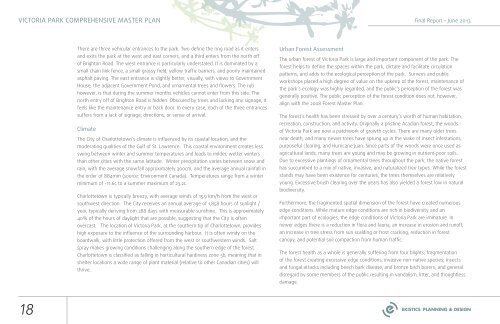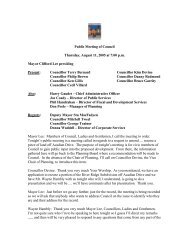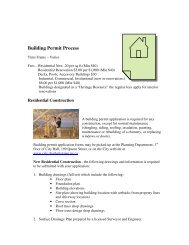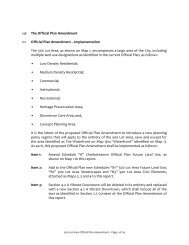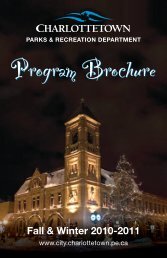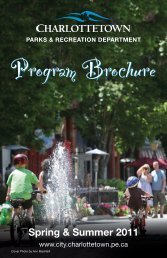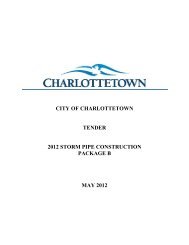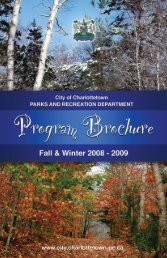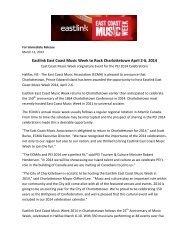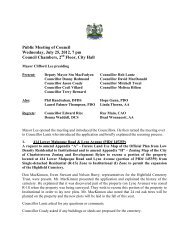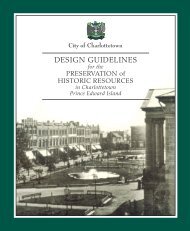Victoria_Park_Re port Final.pdf - City of Charlottetown
Victoria_Park_Re port Final.pdf - City of Charlottetown
Victoria_Park_Re port Final.pdf - City of Charlottetown
Create successful ePaper yourself
Turn your PDF publications into a flip-book with our unique Google optimized e-Paper software.
VICTORIA PARK COMPREHENSIVE MASTER PLAN<br />
<strong>Final</strong> <strong>Re</strong><strong>port</strong> • June 2013<br />
There are three vehicular entrances to the park. Two define the ring road as it enters<br />
and exits the park at the west and east corners, and a third enters from the north <strong>of</strong>f<br />
<strong>of</strong> Brighton Road. The west entrance is particularly understated. It is dominated by a<br />
small chain link fence, a small grassy field, yellow traffic barriers, and poorly maintained<br />
asphalt paving. The east entrance is slightly better, visually, with views to Government<br />
House, the adjacent Government Pond, and ornamental trees and flowers. The rub<br />
however, is that during the summer months vehicles cannot enter from this side. The<br />
north entry <strong>of</strong>f <strong>of</strong> Brighton Road is hidden. Obscured by trees and lacking any signage, it<br />
feels like the maintenance entry or back door. In every case, each <strong>of</strong> the three entrances<br />
suffers from a lack <strong>of</strong> signage, directions, or sense <strong>of</strong> arrival.<br />
Climate<br />
The <strong>City</strong> <strong>of</strong> <strong>Charlottetown</strong>’s climate is influenced by its coastal location, and the<br />
moderating qualities <strong>of</strong> the Gulf <strong>of</strong> St. Lawrence. This coastal environment creates less<br />
swing between winter and summer temperatures and leads to milder, wetter winters<br />
than other cities with the same latitude. Winter precipitation varies between snow and<br />
rain, with the average snowfall approximately 300cm, and the average annual rainfall in<br />
the order <strong>of</strong> 884mm (source: Environment Canada). Temperatures range from a winter<br />
minimum <strong>of</strong> -11.6c to a summer maximum <strong>of</strong> 23.2c.<br />
<strong>Charlottetown</strong> is typically breezy, with average winds <strong>of</strong> 15.9 km/h from the west or<br />
southwest direction. The <strong>City</strong> receives an annual average <strong>of</strong> 1,858 hours <strong>of</strong> sunlight /<br />
year, typically deriving from 288 days with measurable sunshine. This is approximately<br />
40% <strong>of</strong> the hours <strong>of</strong> daylight that are possible, suggesting that the <strong>City</strong> is <strong>of</strong>ten<br />
overcast. The location <strong>of</strong> <strong>Victoria</strong> <strong>Park</strong>, at the southern tip <strong>of</strong> <strong>Charlottetown</strong>, provides<br />
high exposure to the influence <strong>of</strong> the surrounding harbour. It is <strong>of</strong>ten windy on the<br />
boardwalk, with little protection <strong>of</strong>fered from the west or southwestern winds. Salt<br />
spray makes growing conditions challenging along the southern edge <strong>of</strong> the forest.<br />
<strong>Charlottetown</strong> is classified as falling in horticultural hardiness zone 5b, meaning that in<br />
shelter locations a wide range <strong>of</strong> plant material (relative to other Canadian cities) will<br />
thrive.<br />
Urban Forest Assessment<br />
The urban forest <strong>of</strong> <strong>Victoria</strong> <strong>Park</strong> is large and im<strong>port</strong>ant component <strong>of</strong> the park. The<br />
forest helps to define the spaces within the park, dictate and facilitate circulation<br />
patterns, and adds to the ecological perception <strong>of</strong> the park. Surveys and public<br />
workshops placed a high degree <strong>of</strong> value on the upkeep <strong>of</strong> the forest, maintenance <strong>of</strong><br />
the park’s ecology was highly regarded, and the public’s perception <strong>of</strong> the forest was<br />
generally positive. The public perception <strong>of</strong> the forest condition does not, however,<br />
align with the 2008 Forest Master Plan.<br />
The forest’s health has been stressed by over a century’s worth <strong>of</strong> human habitation,<br />
recreation, construction, and activity. Originally a pristine Acadian forest, the woods<br />
<strong>of</strong> <strong>Victoria</strong> <strong>Park</strong> are now a patchwork <strong>of</strong> growth cycles. There are many older trees<br />
near death, and many newer trees have sprung up in the wake <strong>of</strong> insect infestations,<br />
purposeful clearing, and Hurricane Juan. Since parts <strong>of</strong> the woods were once used as<br />
agricultural lands, many trees are young and may be growing in nutrient-poor soils.<br />
Due to excessive plantings <strong>of</strong> ornamental trees throughout the park, the native forest<br />
has succumbed to a mix <strong>of</strong> native, invasive, and naturalized tree types. While the forest<br />
stands may have been existence for centuries, the trees themselves are relatively<br />
young. Excessive brush clearing over the years has also yielded a forest low in natural<br />
biodiversity.<br />
Furthermore, the fragmented spatial dimension <strong>of</strong> the forest have created numerous<br />
edge conditions. While mature edge conditions are rich in biodiversity and an<br />
im<strong>port</strong>ant part <strong>of</strong> ecologies, the edge conditions <strong>of</strong> <strong>Victoria</strong> <strong>Park</strong> are immature. In<br />
newer edges there is a reduction in flora and fauna, an increase in erosion and run<strong>of</strong>f,<br />
an increase in tree stress from sun scalding or frost cracking, reduction in forest<br />
canopy, and potential soil compaction from human traffic.<br />
The forest health as a whole is generally suffering from four blights; fragmentation<br />
<strong>of</strong> the forest creating excessive edge conditions; invasive non-native species; insects<br />
and fungal attacks including beech bark disease, and bronze birch borers; and general<br />
disregard by some members <strong>of</strong> the public resulting in vandalism, litter, and thoughtless<br />
damage.<br />
18


